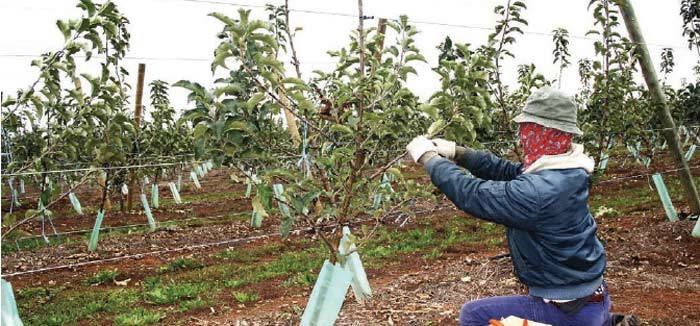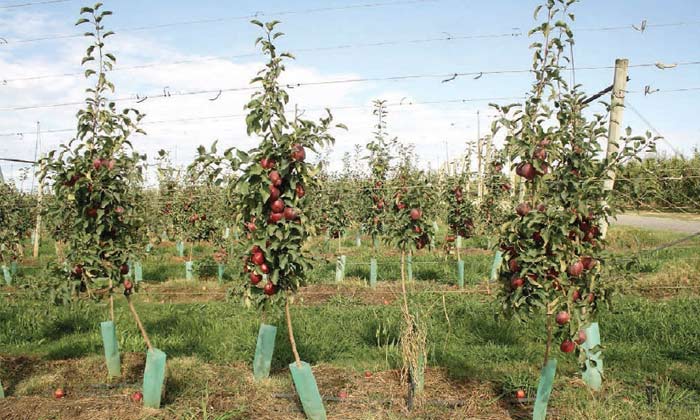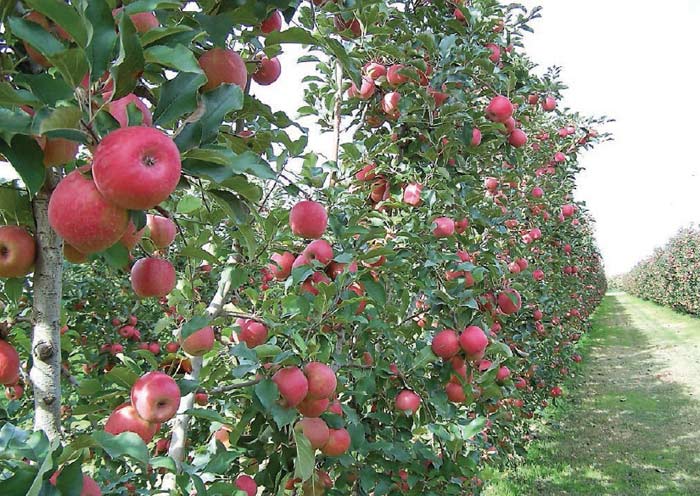
Meticulous training of these 17-month-old apple trees on Malling-Merton 106 lays the foundation of a productive apple orchard. The positioning of the secondary framework (branches) of these Open Tatura trees ensures there won’t be gaps in the canopies between trees. Light interception in third, fourth and fifth leaf is estimated at 45 percent, 55 percent and between 65 and 70 percent, respectively. Trees produced 11 tonnes and 45 tonnes per hectare (4.9 tons and 20.1 tons per acre) in the second and third years, respectively. (Courtesy Bas van den Ende)
In Australia, orchardists’ expectations of early tree growth are generally not high enough: Too much sunlight, and therefore potential crop, is being wasted.
Cropping is directly linked to the amount of sunlight captured (intercepted) by fruit trees. The more light the trees capture, the more crop they can carry. Sunlight that hits the orchard floor is mostly wasted.
Most orchardists do not develop the canopy as quickly as they could.
Although trees are generally planted at the right density and on the right size-controlling rootstocks, insufficient early tree training means that the canopy is not developed as quickly as it should.

These third-leaf apple trees on Malling 9 rootstock on Open Tatura have twice the number of apples on the tree as their average trunk size should have. This has not only restricted canopy development, but also has resulted in more than six different sizes of apples in the unthinned crop. (Courtesy Bas van den Ende)
Pushing the young trees with water and nitrogen is not much good if you don’t guide the new growth toward filling the tree’s space. This is done by summer pruning and tree training.
The quicker you fill the tree’s space on a trellis, the more sunlight its canopy can capture and use the energy of this sunlight to produce fruit.
The highest possible light interception for sustainable high yields of good quality fruit is 70 percent. This allows alleyways between rows for orchard equipment to pass through.
Most of the tree’s permanent structure should be established during the first three years. To maximize early growth of the trees, they should not be cropped in the second year, unless large, well-feathered trees are planted.
Cropping, and sometimes overcropping the trees in the third year, can severely set the trees back, especially when they are on Malling 9 or M.26 rootstock.

Continuous thin, angular canopies, such as this Open Tatura, regularly produce high yields of good quality apples of marketable sizes. Notice the distribution of apples from the top of the canopy to the bottom. The shade pattern on the orchard floor between the rows also indicates good distribution of sunlight throughout the canopy. These trees have been meticulously trained in the first three years, and the orchard now reaps the long-term benefits.(Courtesy Bas van den Ende)
It will be difficult to invigorate young apple trees after they have been overcropped.
Vertical or angular canopies of apple trees that are thin and continuous and have the correct height in relation to the width of the rows should reach the 65 to 70 percent light interception by the fifth year.
When that has been reached, accumulated yields of 145 tonnes per hectare (65 tons per acre) have been recorded from three harvests, with sustainable annual yields of between 65 and 90 tonnes per hectare (29 and 40 tons per acre) of good quality fruit after year five.
If your apple trees do not produce such yields and fruit quality, you should have a look at the architecture of your trees. Gaps in the canopy between trees is a waste of space — space that should be occupied with fruiting wood and apples, not fresh air. •
– by Bas van den Ende






Leave A Comment